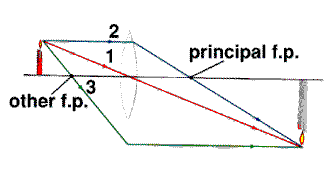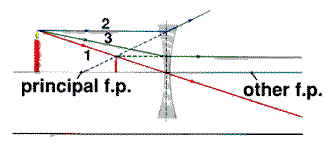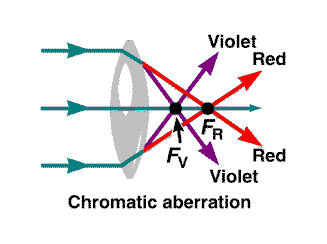
Geometrical Optics



 Lenses
Lenses
|
In order to understand how lenses work, we first need to
consider the
effect of a spherical glass surface
on light rays.
For a converging surface the center of curvature lies inside
the glass (the surface bulges out), and light rays incident parallel
to the axis are bent towards the axis. When parallel rays go from
the glass into air, they are also bent towards the axis.
For a diverging surface the center of curvature lies outside the glass (surface is curved inward into the glass), and light rays incident parallel to the axis are bent away from the axis. When parallel rays go from the glass into air, they are also bent away from the axis.
 Convex or
Converging Lens Convex or
Converging Lens
 Concave or
Diverging Lens Concave or
Diverging Lens
Demo: Focal point of a convex lens.
Try it! Focussing of parallel rays.The image of diverging lenses can be constructed by ray tracing .
 Ray Rules Ray Rulesfor ray tracing with thin lenses.



Tutorials:Knowing the focal length f of a lens, we can construct the image of any object formed by that lens.
 Power of a lens
Power of a lens
The power of a lens is measured in diopters [D]
Example:A lens of a power -2Dhas a focal length of 1/(-2) m or -50 cm. This means, that this lens is diverging.
 Lens Equation Lens Equation
The quantities in the lens equation are defined as follows:
1/(4 m) + 1/DI = 1/(2 m) ==> 1/DI = 1/(4 m) ==> DI = 4 m The Magnification of a lens is defined as: M = - DI / DO
Remember:
Tutorial:
Try it! Measuring your eyeglass prescription.
 Retroreflectors Retroreflectors  Converging lenses can be used to make retroreflectors. Converging lenses can be used to make retroreflectors.
 Water droplets on a grass blade can act as retroreflectors. Water droplets on a grass blade can act as retroreflectors.
 Glass bead with white paint behind them are used as retroreflectors
e.g. in highway signs. Glass bead with white paint behind them are used as retroreflectors
e.g. in highway signs.
 Fresnel Lenses
Fresnel Lenses
The top part of the figure shows a thick, converging lens with one
flat side. Fresnel lenses are used in spotlights. The top of an overhead projector is a Fresnel lens.
 Aberration Aberration
 Spherical Aberation
Spherical Aberation
 Chromatic Aberation
Chromatic Aberation
 A chromatic aberration produced by a converging lens. Rays of different wavelength focus at different points. (The angles are greatly exaggerated for clarity.) Examples of Chromatic aberration and how to deal with it. |

Ch. Elster